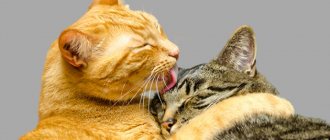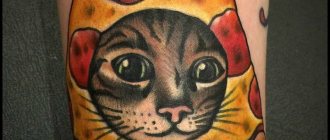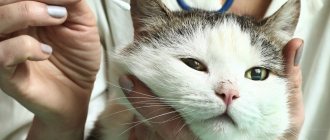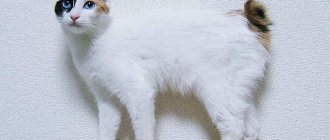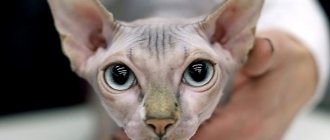- Pets
- >>
- Cat breeds
* Here is a photo of a typical representative of the Bombay cat breed . You can send us photos of your animals by email, and we will post them on the website. Don't forget to send your pet's name.
Other breed names:
Bombay
Video
* We invite you to watch a video about the Bombay cat . In fact, in front of you is a playlist in which you can select and watch any of 20 videos about a given cat breed by simply clicking on the button in the upper right corner of the window. In addition, the material contains quite a lot of photos. By looking at them you can find out what a Bombay cat looks like.
In this article:
|
Rate the material!
[Total votes: 2 Average: 5]
The first thing that comes to mind when you hear the phrase Bombay cat is that it probably comes from Bombay, in India. However, it is not. The breed was developed with the direct participation of breeder Nicky Horner, who had a soft spot for panthers and dreamed of breeding a cat breed similar to them. This woman lived and worked not in India, but in the USA (Kentucky).
Features of feeding
Adherents of natural nutrition for Bombay cats create their own diet. But veterinarians insist that the menu be based on meat products. They can be supplemented with cereals, fruits, vegetables and other ingredients that are allowed for cats. You can feed Bombay cats with ready-made dry food. But it should only be of high quality, with a high content of meat products, essential vitamins and minerals. You need to feed your pet approximately at the rate recommended by the food manufacturer. Typically, an adult healthy animal is given food twice a day.
It is worth noting that Bombays are unusually voracious cats that love to eat their fill. Stealing food and stealing food from the table is a common occurrence for this breed. However, it is important to monitor the amount of food taken so that the animal does not overeat. Otherwise, this risks obesity, which negatively affects health. If the cat has gained a lot of weight, you will have to go to the veterinarian so that he can select a diet.
History of the origin of Bombay cats
The history of the creation of the Bombay cat breed is not so long ago. As it turned out, the American breeder Nicky Horner spent a long time and diligently crossing two breeds: the Burmese and the American Shorthair, wanting to get a miniature copy of the panther, whose beauty and grace she always admired.
Interesting fact: In 1958, the breeder almost succeeded, but the first litter turned out to be completely imperfect. Perseverance is always rewarded, and after a couple of years, Nika finally got a mini-panther with the same shiny fur and graceful body as her wild relative.
The new breed was recognized by the Cat Fanciers Association only in 1970, and already in 1976, at an exhibition, one of the Bombay cats was awarded the title of champion. Many breeders of the Burmese breed were indignant and protested about this, saying that this is not a new breed at all, but just one of the varieties of Burmese. Because of this, Nicky Horner had to give up her dream and stop all work in this field.
However, other breeders - the spouses Suzanne and Herb Zwecker - continued the endeavors of Nicky Horner and in the mid-eighties they received a cat with a perfect black coat color, a future champion who radically changed the opinion about the breed. Today, the genes of this cat are present in the pedigree of most representatives of this breed.
As it turned out, there are still very few registered purebred Bombay cats in the world. At the beginning of the 2000s, the CFA organization registered about a hundred individuals, based on which the breed was only in 34th place out of 40.
Buying a kitten
If you decide to keep a Bombay cat at home, then you should take the choice of a pet seriously. Today, cases of fraud involving this breed have become more frequent. Often, ordinary black yard cats are sold under the guise of purebred babies. By the way, the cost of a Bombay varies from 20 to 120 thousand rubles. It all depends on the character and exterior qualities.
If a kitten is purchased for exhibitions and high-quality breeding, then it must be taken only from a trusted nursery that has documented permission to produce offspring of this breed. Only official breeders can guarantee the purity of a cat, for which a lot of money is paid. But there are very few nurseries in Russia that cater specifically to Bombay residents. Therefore, most likely, you will have to sign up in advance to purchase a kitten.
Bombay cat - description of the breed
From the parent breeds (Burmese, American Shorthair), the Bombay cat inherited their best qualities. The most important feature of these cats is their black fur along its entire length, very shiny, iridescent in the light, which fits tightly to the body and has almost no undercoat. Sometimes kittens may have lighter spots on their fur, but these disappear as they grow older. Real Bombays should have black pads on their paws and toes, as well as their nose.
The body of Bombay cats is of medium size, quite dense, strong and muscular. Males are usually slightly larger and heavier than females. The weight of cats varies between 2.6 - 5.7 kg. The Bombay's legs are not too long, proportional to the body and tail. The feet are rounded. They have five toes on their front paws and four on their hind paws.
The Bombay cat's head is also rounded and its muzzle is wide. When examining the muzzle in profile, the stop of the nose is very clearly visible. In a purebred representative of the breed, the nose should not turn into a break. The nose is slightly flattened and its tip is slightly rounded. The ears are medium in size, also with rounded tips. They are quite wide at the base and slightly inclined forward, which is why the cat often looks wary.
Based on the rather vague formulation of head shape standards, judges at exhibitions can judge exhibited animals in completely different ways. For this reason, the classic representatives of Bombay cats with elongated muzzles occupy both last and first places.
Bombays' eyes are not slanted, like the vast majority of breeds, but round, very bright and expressive, one might even say sparkling.
The color of their iris comes in two types:
- Copper or gold (British Bombays);
- Orange or amber (American Bombays).
At the same time, there is a tendency that in 3-5 year old cats, the eyes gradually become less bright and sometimes even change their color to green. Up to one month of age, kittens have blue eyes, while older ones have gray eyes.
Popular colors of Bombay cats
Initially, the goal of breeding the Bombay cat was to create a mini-panther, exactly the same black and graceful as living in the wild. For this reason, all Bombay cats, in accordance with internationally generally accepted breed standards, are characterized by a rich black coat along the entire length, with an intense radiant, even resinous sheen. No other colors are completely acceptable in this breed.
Interesting fact: It is noteworthy that Bombay kittens do not immediately and do not always correspond to accepted standards, often having both lighter spots on the coat and a slightly brownish (in the light), rather thin, sable-colored undercoat.
It also happens that in a whole litter of purebred Bombays, only one kitten is born with a black coat color, and all the rest, due to the presence of the dominant Burmese gene, are born with a brownish (sable) color. To obtain a pitch-black color for the entire litter, Bombay cats are often crossed with Burmese cats, since the “black” gene is dominant for both breeds. Bombays are rarely crossed with the American Shorthair, since the genes of the former have a bad effect on the physique and grace of the latter.
All Bombays have rather short hair, practically no undercoat, which fits very tightly to the body, which makes it easy to see their strong, muscular and graceful body. Bombays should have the same black nose (outside and inside), paw pads, fingers, whiskers and whiskers.
Character and habits of Bombay cats
Bombay cats are characterized by a strong attachment to their owners, and to all family members, including even small children. They are very sensitive creatures and can easily guess the mood of their owners even by the intonation of their voice. Bombay cats require a lot of attention, constantly reminding them of themselves with various active actions, games, meowing, especially if it is time to feed.
Interesting fact: Bombay cats do not like loneliness and suffer if their owners leave them alone for a long time. To somehow compensate this sociable cat for the lack of communication, you can try to get another cat. Mini-panthers are quite active and playful in their behavior, so they need toys, otherwise they will play with everything.
Bombays are also quite “talkative”, although silent individuals are no exception for this breed. However, for the most part, these cats do not bother their owners with their purring and meowing. Compared to other breeds, their voice is relatively quiet and unsharp.
Bombay cats are characterized by the following qualities:
- Intelligence and high intelligence;
- Non-conflict;
- Sociability;
- Playfulness;
- Endurance;
- Flexibility.
These cats do not tolerate rudeness at all, and can sometimes be vindictive. Therefore, raising one’s voice, and even more so physical punishment, is completely unacceptable for them.
Although Bombays are very attached to their family members, they are quite suspicious of people they do not know. Especially if they are too intrusive and constantly try to pick them up, squeeze them or stroke them.
Character
Animals of this breed are calm and balanced. They are not vindictive, do not conflict with anyone, and are peaceful. Positive character traits include intelligence, attention and intelligence. The cat quickly remembers what it can and cannot do. They are well trained and perceive training as a game. Animals love their owner and his family members and try to constantly be near them.
These pets require a lot of attention and love to lie on your lap. They are able to guess the mood of the owner and capture the intonation of the voice. Left alone, they begin to feel sad. Cats love to play, so they need to buy toys. They are on equal terms with other animals. They willingly play with children, but in moderation. They do not tolerate it when a child shows aggression or excessive intrusiveness towards them. When a stranger appears, they become wary.
Bombays are able to control their emotions. Even in a stressful situation, they will not show inappropriate behavior. They like to spend time at home rather than walking outside. Animals with this character should be owned by older people.
Interesting facts about Bombay cats
Due to their very sociable nature, Bombays absolutely cannot stand loneliness. They miss their owners very much when they are away and always follow them around like dogs when they return home.
Contrary to the popular belief that all cats are difficult to train, the Bombay cat is very easy to teach some tricks, for example, fetching different objects (a ball, small toys), throwing them and rewarding the animal with something tasty. Sometimes 2-3 lessons are enough for the cat to remember the acquired skills and understand what they want from her. Also, these smart animals can easily figure out how to open a door or refrigerator.
Bombays live quite a long time - 13-20 years. Their life expectancy is influenced by lifestyle, nutrition, health, and activity. The Bombay cat is still a rather rare and small breed. In this connection, it is often compared to a jewel.
Representatives of the breed are not very fond of walking outside, although if the cat is accustomed to walking from a tender age, then no problems arise. In this case, be sure to take care of a comfortable harness with a leash in advance. Free-ranging is taboo for Bombays, since hybrid breeds are very susceptible to various feline viruses.
Bombay cats prefer to sleep not curled up in a ball, but lounging or stretched out to their full length. They often sleep in the master's bed, which creates inconvenience. For this reason, the animal’s sleeping place should be quite large and spacious.
It has been proven that Bombays develop and mature for quite a long time - almost 2 years. There is an opinion among designers that the popularity of Bombay cats began to grow with the introduction of fashion for Scandinavian-style interiors. This minimalist style with a variety of dark tones highlights the beautiful, graceful pet with sleek, iridescent blue-black fur.
Care and maintenance
The Bombay requires grooming to keep its coat sparkling clean. The first molt can be observed at about one year of age. At this time, the downy brownish coat, which does not have an undercoat, must be combed out with a brush. And, even if the animal seems “undressed” for some time, then pretty soon it will grow new hair. Combing with a special brush is carried out weekly, and during the molting period this will have to be done more often. After brushing the cat, you need to run a damp hand over its body to collect individual fallen hairs. To add shine, the cat's fur coat is “polished” with suede cloth.
These cats are not great lovers of water, so bathing them is not recommended. It is enough to do this once every six months. The shampoo must be chosen so that it matches the type of coat, otherwise the cat may develop dandruff and irritation, and the coat may become dull.
Claws should be trimmed as they grow, but for cats that actively use a scratching post, this procedure is not necessary.
The cat's ears and eyes should be examined regularly; any contamination found should be wiped with a slightly damp cotton swab. If there is unusual discharge from the eyes, you should immediately contact your veterinarian for treatment. Since gum problems are not uncommon for Bombays, you need to pay special attention to the oral cavity, remembering to regularly brush your pet’s teeth with a special brush and paste.
A pleasant bonus of this breed is its cleanliness. If the cat's litter box is washed in a timely manner and the filler in it is changed, then there will be no unpleasant odors. Veterinary pharmacies sell special sprays that quickly deal with the unpleasant odor.
Also, do not forget about the necessary vaccination of the animal and prevention against worms.
In order for the functioning of the gastrointestinal tract to be well-functioning, the cat should be given only balanced food, and in no case should it be overfed, even if it is trying to “hypnotize” you with its gaze with the most hungry look. High-quality dry professional food is preferable. For adherents of “natural” it is necessary to control the balance of nutrients, vitamins and minerals. For animals prone to obesity, this is especially important.
Bombays' diet may include: turkey or chicken, lean boiled meat and offal. Periodically, but not often, the cat is given a boiled egg yolk. For kittens, porridge made from oatmeal and buckwheat is useful. At the same time, river fish, salted and smoked foods from the owners’ table are absolutely prohibited.
In winter, the cat especially needs vitamins, so it is recommended to give it fish oil capsules. It contains OMEGA-3, thanks to which the cat will not suffer from dry skin, and its coat will become shiny and strong.
For Bombays, a sense of absolute security is important, especially when they are sleeping or just relaxing. Therefore, the cat’s sleeping place should be arranged in the most secluded place where it will be calm. The animal needs to be provided with a sufficiently large bedding, since these cats do not sleep in the usual way, like their counterparts - curled up in a ball, but stretched out to their full length. At the same time, it is of great importance for a cat to be close to members of the household, which means that the bed needs to be placed in a place where the pet can not only rest, but also comfortably observe everything that is happening around.
The excessive activity of cats of this breed indicates that they simply need a sufficient number of different toys and “entertainment”. Otherwise, bored alone, the Bombay cat will easily start playing with any object that comes into its paws.
Bombays are very thermophilic, so the temperature in the apartment must be strictly defined. If there is a draft in the rooms, the cat may catch a cold.
Thanks to its fairly developed intelligence, it is not difficult for a Bombay cat to get used to a litter box, walking on a harness, as well as various hygiene procedures, such as combing and bathing. Already from childhood, the cat must be accustomed to the place where it will sleep (it should be quite spacious and without drafts), and also behave correctly - not climb on the table and, especially, not carry food from there.
Bombays are passionate about pleasing their owners, so they learn quite quickly. Performing simple tricks is easy for them and even gives them pleasure. For example, when following commands, they can stand on their hind legs, make a voice, jump over an obstacle, or bring a toy in their teeth. If the owner plans to train a cat, then this should be done starting from an early age, reinforcing commands with affection or treats. If a cat is forced to perform tricks or raised his voice at her, then she may refuse to perform them forever.
Pros and cons of Bombay cats
The positive qualities of the incredibly beautiful and rare Bombay cats include a very impressive appearance and grace, as well as an almost complete resemblance to a panther. For all its somewhat “wild” appearance, the animal has a very affectionate and friendly character, is not too talkative, is very attached to its owners, does not trust strangers, but at the same time tolerates the presence of a dog in the house.
Another undeniable advantage of Bombays is that they get along well with people, both adults and children. The cat is simply very smart, one might even say intellectual, it understands its owners well, their commands, it can learn to be friends, help, fetch a ball and other small objects, hold a toy in its paws, and open a door with its paw. She does not require special treatment or attention at all, is very unpretentious in nutrition and quickly adapts to a new environment for her.
The negative aspects of the breed include the manifestation of genetic diseases. This is due to the fact that the breed is hybrid and still quite young. Bombays are characterized by the occasional occurrence of problems with the ears, eyes, gums, and viral diseases. For this reason, eyes, ears and gums require close attention and control.
Bombay cats are also prone to obesity because they almost never suffer from lack of appetite and the ability to control the amount of food they eat. Another disadvantage, although quite strange, is that Bombays often cannot get along with other cats, although they are quite tolerant of dogs.
Breeding Bombay cats
Sexual maturity in Bombays, like in most cats, occurs at the age of 6-9 months, but their entire body is finally formed only by two years. Breeders do not recommend planning mating before the animal is two years old, since the quality of the offspring directly depends on this. If the cat's owners do not intend to breed the breed, then it is better to sterilize it at the age of puberty.
Bombay breeding is usually done where the male lives. It is worth noting that males are very lazy in this regard and it is quite possible that there will be a need to repeat mating and even more than once. The most crucial moment when breeding Bombay cats is the careful selection of parents, because the future offspring should not have any deviations from the accepted breed standards.
Estrus in cats first appears at 6-8 months and lasts about a week. If fertilization does not occur, then estrus repeats after three weeks. The best time to breed Bombays is 3 or 4 days after the start of estrus. Pregnancy in cats lasts approximately 65-70 days. The offspring should not be born prematurely, since premature kittens have an underdeveloped nervous system and an inferior sucking reflex. During childbirth, it is better for the owner to be close to the cat in order to help her in case of complications. The Bombay litter is not too numerous - up to 4 kittens.
Interesting fact: Newborn kittens usually have blue eyes, which become gray as they grow older, and closer to six months of age - golden or amber. If the weight of kittens does not exceed 75 g, then they require additional feeding from a pipette. It is advisable not to pick up kittens under the age of 7 days, so as not to cause injury to them.
Even if the parents are the most purebred Bombays, it often happens that some kittens from the litter have small spots of a brownish tint on their fur. This phenomenon is not considered a defect, because the spots disappear over time and the coat acquires an even, bluish-black hue. In nurseries, professional breeders give kittens to new owners at the age of 3-4 months, when they already know how to go to the toilet on a tray and use a scratching post.
Castration and sterilization of Bombay cats
Castration is an operation to remove the sex glands. Sterilization involves only ligation of the fallopian tubes - the production of hormones will continue, and sexual desire will remain. Therefore, if the owners’ plans do not include reproduction, it would be more humane not to sterilize, but to castrate the animal - in this case, the pet will be insured against the possible development of ailments of the reproductive system, will become calmer and more balanced, and its quality of life will increase.
If a cat is not supposed to give birth, then she needs to be neutered.
If a cat is not bred, but she is in heat, she may get sick. Abstinence in cats usually leads to gynecological diseases (including uterine cancer). If you plan to remove only the ovaries, it is best to castrate the animal before the first heat and signs of sexual desire appear - in the future, this will almost completely eliminate the risk of developing uterine cancer.
Such operations are carried out in animal clinics where there is a veterinary surgeon. The pet is brought in in advance (the day before), he is not fed (not required before the operation), but he is observed and the necessary tests are taken. The surgery itself takes place under general or local anesthesia. Local anesthesia is usually sufficient for cats, but the surgery performed on a cat is abdominal, requiring general anesthesia.
We didn’t wait for the guy’s hormones to start raging. At seven months they took him for castration. He tolerated the operation well. It was a bit difficult to recover from anesthesia: there was weakness and drowsiness. But within a day he was again rushing around the house like a hurricane.
perfectionist, forum user
https://otzovik.com/review_1194188.html
I sterilize all my cats because they are always outbred. I wait until the cat is one year old and start looking for a clinic. I spayed my last cat when she was one and a half years old. The operation itself took about ten minutes, but the most difficult thing was the care after the procedure. The cat recovered from anesthesia for almost a day.
Video: how to care for your pet after surgery
Caring for Bombay cats
Caring for mini panthers is not too difficult.
To do this, just do the following:
- Brush the coat with a soft brush (once a week);
- Wipe the corners of the eyes with a moistened cotton pad (as they become dirty, once every 2-3 days);
- Check the ears and if dirt is found there, then wipe them with a cotton swab dipped in chamomile decoction or a solution of vinegar and warm water - 50 to 50 (once a week);
- It is important to constantly monitor the cleanliness of the dishes, feeding area and tray, since Bombay cats are simply unsurpassed cleanliness who are very sensitive to their hygiene.
Needless to say, the animal must have its own sleeping place, and not one, but two or three, in different places in the house or apartment. This way, cats will not claim the master's bed, which often happens due to their strong attachment. Having a good scratching post is a must, since this cat device greatly simplifies the care of claws; they will not need to be trimmed often. The Bombay's short coat does not require any special care. It does not require frequent combing and frequent washing, and almost does not fall out.
The most necessary things for a Bombay cat:
- Bowl (preferably made of metal);
- Tray (plastic or metal, always with high sides);
- scratching post;
- Sleeping place (preferably 2-3 sun loungers);
- Toys.
Frequent water treatments are not recommended for cats. If the cat never goes outside at all, then one bath every six months is enough. For bathing, it is better to use special shampoos or, at worst, baby soap. If you bathe your pet too often, it may develop allergies.
Cats must be regularly vaccinated and given deworming medications. If a kitten is purchased from a nursery, the buyer must be provided with a vaccination certificate.
Catering
Bombays love to eat and lick their bowls until they shine. But too much food will turn from an elegant and graceful animal into a clumsy bun, suffering from shortness of breath, palpitations, diabetes, or worse. Therefore, remember the following:
- The cat must not be overfed! Adult animals (over six months old) eat 2 times a day: morning and evening. An exception can be made for lactating and pregnant females, sick or elderly animals. Teenagers 4-6 months eat 3-4 times, babies – 5-6.
- The animal should be switched to a new food gradually, and not suddenly change the diet. Apart from indigestion, this will not bring any benefit.
- You cannot mix natural food and ready-made food: choose one.
- Your cat should have separate bowls for water and food. It is advisable to wash the dishes after each meal so that they do not stagnate and become saturated with an unpleasant odor.
- Be sure to clean drinking water from harmful impurities and chlorine. A regular faucet filter will help with this. Or you can leave the liquid in a jar without a lid for 8-12 hours in a dark place.
Natural products
The following natural products are allowed:
- Meat. Only low-fat varieties: rabbit, turkey, veal, beef. The meat is pre-frozen, and before feeding it is thawed and doused with boiling water to destroy possible parasites. They feed the meat every day, cutting it into pieces 1-2 cm long. Fat layers, bones, and skin are removed. The exception is chicken necks: they are ground into minced meat along with cartilage.
- Fish. Salmon families: chum salmon, pink salmon, salmon, river trout. Or lean (if the cat is on a diet): blue whiting, cod, hake. All sharp parts, bones and fins must first be removed. It is also undesirable to give heads and milk. The fish is boiled for at least 20 minutes in unsalted water and given once a week. More often it is impossible - excess fish leads to the development of urolithiasis.
- By-products. This is an additional source of minerals and vitamins. Liver, hearts, ventricles - boiled or raw.
- Dairy products. Low-fat cottage cheese, natural yogurt without dyes and other additives, kefir, fermented baked milk, yogurt, low-fat sour cream.
- Eggs. Chicken ones are boiled and only the yolk is given to the cat (the protein gives the cat diarrhea), quail ones are fed whole.
- Porridge. Buckwheat, rice, oatmeal, barley. Porridge can be included in the diet when the kitten is 1.5 months old: first they are cooked in milk, and then in vegetable or meat broth. You can feed porridge every other day in the proportion of one part porridge to 3 parts meat.
- Vegetables. No more than 10% of the daily food intake. Zucchini, carrots, broccoli, asparagus, green beans, celery, beets. You can’t give them raw ones – the cat might choke! The exception is cucumbers and melons. They perfectly quench thirst. The hard skin can be removed.
It is prohibited to give:
- Pork and pork by-products (contains histamines), goose, duck and lamb (poorly digested), fresh liver and raw lung (causes diarrhea and vomiting), minced meat from the store (it often contains skin and fat);
- Corn, pea, millet porridge, semolina (it is acceptable to feed babies liquid semolina porridge with milk), instant porridge;
- Avocado, garlic, onions, grapes, raisins (and dried fruits). Potatoes cause constipation, so you should be careful with them;
- Sweet, smoked, salty, flour, baked goods;
- Dog food;
- Human vitamins;
- Tea, coffee, cocoa, whole cow's milk, mineral and sparkling water, juices, compotes.
Recommended food
Among industrial feeds, holistic and super-premium class feeds are considered the best. These are Fitmin Purity, Go Natural, Arden Grange. The rest - food from the economy and premium groups - are made from meat waste (rather than pure meat), contain chemical preservatives, dyes and flavor enhancers, which, naturally, will not benefit the cat.
Below are the recommended holistic and super-premium foods. Links with the names of the food are clickable, on them you can, within our website, get acquainted with the descriptions of the food and read reviews from the owners of the Bombay cat breed.
| Holistic | Holistic | Super premium |
| Canagan | Gather | Bozita |
Bombay cat diet
Bombays are usually not fussy about their diet, but a balanced diet is very important to them. A particularly important point is teaching your cat to eat discipline. This is necessary because Bombays are prone to gaining excess weight. It is worth noting that cats of this breed have a good appetite, so a clear diet is necessary, and eating from your own table is prohibited. At the same time, mixing types of feeding (dry and natural) is strictly not recommended.
When feeding Bombay cats, high-quality dry food is preferable, since this factor directly affects the condition of the coat. In order for a cat to have a presentable appearance and shiny coat, it needs premium food. In winter, it is useful to introduce fish oil, vitamins, and vegetable oils into the cat’s diet. The Bombay diet can also consist of the most common foods.
In this case, the diet should include:
- Fresh offal (liver, heart, kidneys, chicken gizzards);
- Fresh meat (chicken, beef, rabbit);
- Boiled vegetables (pumpkin, zucchini, carrots, cauliflower);
- Dairy products (low-fat cottage cheese, kefir, milk - if there is no intolerance);
- Porridge (wheat, buckwheat, oatmeal, barley).
The optimal ratio of fiber to protein is one to four. Milk-fed kittens should be gradually introduced to an adult diet by offering them “adult” food. It is ideal if it is ready-made food for kittens, since it contains the necessary complex of vitamins and microelements. It is advisable to pre-boil natural products of animal origin - meat, liver, fish, egg yolks and cut them into small pieces before serving.
Diseases and health problems
Bombay cats usually get sick very rarely, but they do have eye problems, which include excessive tearing. If your pet is experiencing excessive tearing, you should wipe the corners of the eyes daily with a moistened cotton swab.
To moisten the tampon, you can use a decoction of chamomile or calendula, weakly brewed tea, or a very weak soda solution (0.3 teaspoon of baking soda per 500 ml of water). If the discharge from the eyes at some point becomes purulent, then the cat should be urgently shown to a veterinarian, who will decide how the pet can be helped.
A very rare disease of Bombay cats that is transmitted genetically is hypertrophic cardiomyopathy. Its essence is a defect in the heart muscle, which is why animals live very short lives. Responsible breeders always try to exclude animals with defective genes from breeding.
Another genetically transmitted problem is a malformation of the skull (craniofacial defect). This problem affects the development of the fetal skull, which is why kittens are born non-viable due to significant deformations of the head.
In general, Bombay cats may have the following health problems:
- Congenital heart diseases (hypertrophic cardiomyopathy);
- Inflammation of the gums;
- acute respiratory infections, nasal congestion;
- lacrimation;
- Tendency to gain excess weight;
- Helminths;
- Fleas and ticks.
Like any other cats, Bombays can suffer from parasite infection (worms, fleas), which, however, can easily be solved with the help of special medications (tablets, drops, shampoos, sprays, etc.)
Kitten cost and choice
The average price is 10-60 thousand rubles. depending on the category. Show kittens are more expensive, but pet-class animals are cheaper. The difficulty of choosing lies in the fact that only after they finally mature, Bombays acquire their main features, and at first the kittens may be of uneven color, with blue or gray eyes. Much later, the animals become coal-black, and the shade of the eyes changes to amber-gold. This is why breeders often offer older kittens to make it easier to evaluate all their characteristics. This usually happens by 4 months.
When purchasing a kitten from a breeder, it is important to pay attention not only to the accompanying documents, but also to the character and behavior of the animal. The desire to play, lack of fear towards humans, good appetite - all this testifies in favor of the animal. Also, a self-respecting breeder will not sell a kitten before they are at least 12-16 weeks old, since it is at this point that the main external signs are formed. You need to book a kitten in advance - breeders with a good reputation have a waiting list of 6-12 months.
If you want to find a kitten cheaper, you should look at advertisements on the Internet, where offers are published even for 100 rubles. Often people who move to another country give away an animal for practically nothing. Owners do the same if they suddenly develop an allergy to wool. Therefore, with the right skills, finding a kitten at an affordable price is quite possible. However, Bombays are less common in shelters - they are purebred animals that cost a lot of money, and are rarely thrown into the street.
Attentive care and care will help you make friends with the Bombay cat, and he will certainly reciprocate the owner's feelings.
Photo gallery of Bombay cats:

